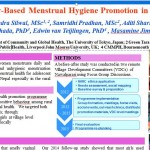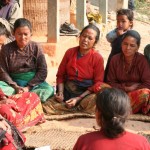 Yesterday HSC Ph.D. student Sheetal Sharma presented her key research findings under the title ‘Getting women to care: mixed–methods evaluation of maternity care intervention in rural Nepal’ at the 30th congress of the ICM (International Confederation of Midwives) in Prague. Sheetal’s Ph.D. evaluates the effectiveness of a health promotion intervention aiming antenatal care attendance in rural Nepal. Her evaluation suggests that practice should be socio-culturally appropriate and inclusive not only of women but also their families.
Yesterday HSC Ph.D. student Sheetal Sharma presented her key research findings under the title ‘Getting women to care: mixed–methods evaluation of maternity care intervention in rural Nepal’ at the 30th congress of the ICM (International Confederation of Midwives) in Prague. Sheetal’s Ph.D. evaluates the effectiveness of a health promotion intervention aiming antenatal care attendance in rural Nepal. Her evaluation suggests that practice should be socio-culturally appropriate and inclusive not only of women but also their families.

This afternoon three HSC posters were displayed as part of a special session on Midwifery in South Asia. All three posters featured aspects of maternity care research conducted in the Centre for Midwifery, Maternal and Perinatal Health in Nepal.
Poster 1: Staff perspectives of barriers to women accessing birthing services in Nepal: A qualitative study
Milne, L, Hundley, V, van Teijlingen, E, Ireland, J, Simkhada, P,
Poster 2: Pregnant & Dirty?
Sharma, S., van Teijlingen, E., Hundley, V. Simkhada, P., Angell, C.
Poster 3: Getting women to care in Nepal: A Difference in Difference analysis of a health promotion intervention
Sharma, S. Sicuri, E., Belizan, JM., van Teijlingen, E., Simkhada, P., Stephens J., Hundley, V., Angell, C.
Prof. Edwin van Teijlingen
CMMPH
 Health Promotion intervention planning in rural Nepal
Health Promotion intervention planning in rural Nepal BU poster at First National Conference on Adolescent Health & Development in Nepal
BU poster at First National Conference on Adolescent Health & Development in Nepal BU well represented at Global Women’s (GLOW) Research Conference
BU well represented at Global Women’s (GLOW) Research Conference










 Up2U: New BU academic publication
Up2U: New BU academic publication New BU midwifery paper
New BU midwifery paper BU academic publishes in online newspaper in Nepal
BU academic publishes in online newspaper in Nepal Final day of the ESRC Festival of Social Science
Final day of the ESRC Festival of Social Science Using Art to enhance Research
Using Art to enhance Research ECR Funding Open Call: Research Culture & Community Grant – Application Deadline Friday 12 December
ECR Funding Open Call: Research Culture & Community Grant – Application Deadline Friday 12 December MSCA Postdoctoral Fellowships 2025 Call
MSCA Postdoctoral Fellowships 2025 Call ERC Advanced Grant 2025 Webinar
ERC Advanced Grant 2025 Webinar Horizon Europe Work Programme 2025 Published
Horizon Europe Work Programme 2025 Published Horizon Europe 2025 Work Programme pre-Published
Horizon Europe 2025 Work Programme pre-Published Update on UKRO services
Update on UKRO services European research project exploring use of ‘virtual twins’ to better manage metabolic associated fatty liver disease
European research project exploring use of ‘virtual twins’ to better manage metabolic associated fatty liver disease